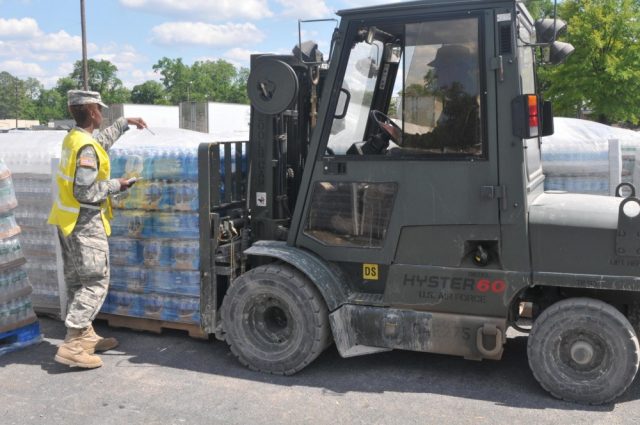
By Michael Tomberlin
Alabama Newscenter
The Alabama National Guard had its largest mobilization for a domestic response when the April 2011 storms and tornadoes devastated the state.
The public saw and experienced that, as soldiers and airmen were visible bringing relief throughout the state.
What the public didn’t know is that the Alabama National Guard had changed the way it manages natural disasters just days before the tornadoes hit, holding its first training exercise as a unit on April 9-10, 2011. The hope was to be prepared in time for the start of hurricane season on June 1 of that year. As it turned out, they would have to be ready much sooner.
“Before April of 2011, any kind of disaster response from Joint Force Headquarters was basically around a couple of folks and then we would add in staff from other staff sections, really like a pickup game of basketball,” said Col. Thomas Tyler, director of Military Support (DOMS) for the Alabama National Guard. “As far as managing the statewide response, it was really you got who you got.”
Retired Col. Jim Hawkins was deputy DOMS at the time and played a key role in the formation of what was known as the Core 30 but would later be known as the Domestic Operations Group, or DOG.
“Alabama’s a disaster-prone state. We have lots of disasters, unfortunately,” Hawkins said. “For years in Alabama, what we did when a disaster reached a level that the National Guard’s assistance was required – which was fairly common – we would put together an ad hoc staff to provide leadership in what we call mission command for that task out of the headquarters staff.”
Hawkins said this approach wasn’t very efficient because the team would never have the same people and it would take time for everyone to get up to speed on what needed to be done.
So Hawkins and the DOMS at the time, Col. Jeff Smitherman, convinced the adjutant general of the Guard to create the DOG and have dedicated personnel whose job would focus on domestic response operations – using their full-time jobs and drill weekend time training and developing plans, and developing knowledge about how in-state domestic operations work differently than overseas combat operations.
“Once you’re in the crisis is not the time to pull out the rule book and say, ‘Let me see what I’m allowed to do again.’ You just have to know because speed is of the essence,” Hawkins said. “Speed is absolutely critical in domestic operations because people are suffering and in this case it’s your own people – it’s the people of Alabama that expect their government to bring all of its resources to bear to assist them in their hour of need, and the National Guard is an important part of that.”
Alabama Gov. Kay Ivey said the Alabama National Guard was one of the many bright spots in the darkness that was the April 2011 storms.
“Ten years later, we still mourn the … lives lost to the devastating April 2011 tornadoes that ravaged our state. However, in true Alabama nature, we have built back stronger, and that is because 10 years ago we came together and had a strong response,” Ivey said. “The Alabama National Guard played an important role in that response. As we all know, the April 2011 tornadoes produced total devastation in various areas in our state, and in those extreme circumstances, the Guard stood ready, stepped in and was there to protect personal property. A strong storm system means we have a stronger response, and Alabama accomplishes that every time.”
Alabama Emergency Management Agency Director Brian Hastings said the Guard is unlike any other organization when it comes to the state’s ability to respond to a disaster.
“The Alabama National Guard is an invaluable partner during all phases of disaster response,” Hastings said. “They have many unique capabilities that no other agency in the state can offer and are capable of deploying those capabilities anywhere at any time, if required.”
‘We go for perfect’
Because the April 2011 response was being run out of Montgomery, which didn’t experience the kind of devastation of other communities in the state, Hawkins worried that after the first week of the response it was beginning to feel too much like a training exercise for his team. He began sending staff members to the field to see the scenes and have greater empathy for what the soldiers and airmen were experiencing as they provided relief to others.
“So when they came back to the ops center, they knew they weren’t in an exercise,” he said. “They knew people, their fellow soldiers and airmen, were counting on them and they knew the survivors of that disaster were counting on them. It kept it real to them. I can remember many times my soldiers and airmen coming back in with tears in their eyes saying, ‘We’ve got to work harder.’”
It’s a mindset that Hawkins said became ingrained in the way the DOG does business.
“We have a saying in the DOG: ‘We go for perfect.’ It’s not that we think we’re perfect, but we go for perfect because the people that depend on us deserve perfect,” he said. “The people who depend on us deserve our very best work. A simple error in a written order could cause issues for days out in the field, and they’re in an austere environment, they’re in a challenging situation. We’re in the ops center and we need to have our work perfect so that their lives are as smooth as possible.”
The current DOMS, Tyler, said the experiences from April 2011 created something that has been vital in the Guard’s response to every crisis since.
“The 2011 tornadoes also kind of moved the state in the direction where we have to be a little more prepared, not just down at the unit level, the soldier level, the airman level, it’s more at a staff level of identifying those tasks that we are most likely to be called upon to perform in support of our elected officials and civil authorities,” he said. “So, things got a little more serious after that.”
Whether it’s tornadoes, hurricanes, floods, winter storms, civil disturbances or even a pandemic, the seeds sown in April 2011 still bear fruit when the Alabama National Guard is needed, Tyler said.
The Alabama National Guard’s response to the April 2011 storms totaled more than 31,200 man-days by nearly 3,000 soldiers and airmen. By comparison, Hurricane Ivan accounted for just over 12,000 man-days. The Guard operated in 19 counties across the state, fulfilling more than 100 separate requests for assistance from the Alabama Emergency Management Agency.
Among the missions it conducted were search and recovery, traffic control, security patrols, power generation, transportation, aviation support and food and water distribution that took place from Tuscaloosa to Guntersville and from Hackleburg to Birmingham.
“We proved that concept worked, that core staff worked,” Hawkins said. “Even though they had just come together, they knew they owned that disaster and they knew they would own the next one and they needed to continue to get it right.”
In the time Hawkins was deputy DOMS or DOMS, the DOG worked 22 real-world events and the DOG got proficient at what it did. Other states wanted to learn how Alabama organized it and then started copying it.
“Kentucky formed the Crisis Action Team; they called it the CAT. Colorado formed their Colorado Operations Group; they called it the COG,” Hawkins said. “These were all descendants of an idea that came from Alabama and the great men and women of the Alabama National Guard.”
Today, Hawkins works for Dynamis as the senior principal for Emergency Management and Huntsville Operations. He recently completed a stint as the governor’s interagency coordinator for Alabama’s Unified Command for the COVID-19 response, a position where Dynamis loaned him to the governor’s office free for three months.
Hawkins said the DOG proves the value of having plans for virtually any type of disaster and training against those plans to make sure they work. It’s the difference, he said, between a “do your best” reaction and an organized event response.
“The Guard’s full of great people. We’re going to do our best and it’s probably going to turn out pretty decent because we have lots of resources and lots of smarts,” he said. “But the people who count on us deserve more than just doing our best. They deserve an organized event response.”
And no thought is ever given to not succeeding, he said.
“In domestic operations, failure is not an option because the people of Alabama are counting on you.”




